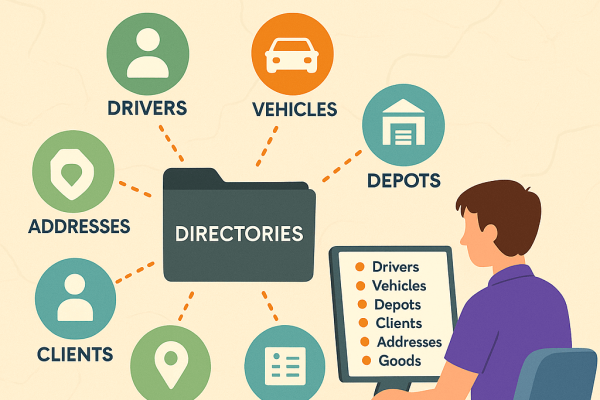The Ultimate Driver Management Guide 2024 + Free Driver Performance Checklist
by
Andrew Baturin
June 27, 2024
You are running a delivery business and trying to stay on top of every process that happens simultaneously, including managing your drivers.
We get it - it's hard and time-consuming, and now it might be more challenging than ever!
This blog post is a guide that discusses all important aspects of the driver management system. It focuses on how to manage drivers in 2024 and gives comprehensive guidance on that aspect.
Stay till the end if you want to learn more about the topic.
Table of content
What is driver management?
Which are the most important driver management practices?
How to manage drivers - comprehensive, all-in-one guide
The importance of keeping drivers updated
What is driver management?
Driver management refers to monitoring, coordinating, and overseeing the activities of the driver hired to distribute packages for one delivery company.
Drivers must be coordinated and managed to perform their duties safely and accurately.
Driver management should be a top priority for any successful delivery company, covering several important elements discussed below.
Which are the most important driver management practices?
It can all start with just hiring one unsatisfactory driver, which could result in a loss to a fleet.
That’s why knowing what are the most important driver management practices is essential:
Driver selection refers to planning to fill driver job openings and match the right driver.
This process establishes minimum applicant qualifications for the position's driver and non-driving duties, which is the foundation of successful driver management.
Delivery fleet managers should consider using effective hiring tools like:
- Application form
- Preliminary interview
- Written examination
- Road test
- Pre-placement medical examination
- Past Employment
- Initial performance evaluation
- Motor vehicle record check
- Driver placement
By driver placement, we refer to job placement, which involves fitting the driver’s strengths and preferences to the job because employees tend to be satisfied and work better at jobs they like.
Delivery fleet managers must be aware that most fleets have a significant variation in output among drivers. This means that the difference between the marginal performer and the true professional often lies in job knowledge, degree of skill, and attitude.
Appropriate workforce training is important in realizing a fleet’s productive potential.
Supervising the drivers who work for you involves carrying out management policy by properly using staff, equipment, and materials.
That noted, these are some of the management principles that have proven to be consistently effective:
- Establishing productive and measurable production goals
- Organizing plans to meet operational objectives
- Showing leadership because drivers need clear directives
- Measuring work as it progresses
- Reviewing the outcome of each plan to determine whether the overall goals were met
- Periodic evaluation of driver’s performance to detect if there are poor driving habits
- Discussing potential driving issues with the driver to improve driving performance
How to manage drivers - comprehensive, all-in-one guide

To be successful in the delivery business industry, managers must develop a proper, effective driver management strategy.
Amongst other things, it is also one of the essential key elements that ensures streamlined processes, which leads to an effective
Let's take a look into how delivery fleet managers should manage their drivers the right way.
By introducing drivers to the basics (giving them handbooks)
To ensure drivers understand their responsibilities when operating fleet vehicles, it's crucial to provide clear instructions in a driver’s handbook.
One aspect of these driver’s handbooks should be based on safety in the workplace (Health & Safety at Work Act 1974, section 7) so drivers are aware of their well-being and that of others while at work.
Statistics show that driving poses the highest risk among employee activities, meaning it is vital to establish correct procedures from the start.
Other than this, the handbook should also be directed toward specific work-related needs so instructions can include:
- Basic orientation to company procedures
- Equipment familiarization
- Apprenticeship with experienced employees
- Supervised on-the-job training
- Classroom work
- Group meetings
- Self-taught correspondence courses
Placing a copy of your organization’s driver handbook in all fleet vehicles and familiarizing drivers with its contents before vehicle use is highly recommended.
Making sure drivers have the right driver's licenses
Regular driver's license checks are essential for all employees who drive as part of their job and should be incorporated into your fleet management policy. These checks safeguard your organization from legal consequences and fines and contribute to road safety.
Under the Road Traffic Act 1988, it is illegal for anyone to drive without a valid license knowingly, and employers are liable if they allow drivers to operate company vehicles without one.
Given that many organizations utilize specialized vehicles, it's crucial to verify that drivers possess the necessary licenses for the specific vehicles they operate. Implementing regular checks helps mitigate potential risks associated with improper licensing.
Adequate driver training
Drivers must be trained to be more efficient.
This means that to perform in the best way possible, they must improve their skills and stay on top of any delivery trends.
Ensure you provide drivers with knowledge on how to carry out their job responsibilities as safely as possible.
Monitoring driver's performance (real-time tracking)
Drivers are constantly on the road, taking routes and stops as they go, meaning they must be supervised somehow. All routes and stops drivers have daily must be considered in reflecting their overall performance.
Otherwise, there is a big chance they won’t be as productive as they should be.
By using a smart strategy, you can closely monitor your drivers' movements as they happen. With drivers always on the go, tracking their whereabouts enhances safety, streamlines routes, and cuts costs. You'll always know where they are, allowing you to adjust to delivery changes, handle rush orders, and manage cancellations smoothly.
Introducing a delivery driver schedule software lets you monitor real-time availability, boosting efficiency, productivity, and customer service satisfaction.
Measuring driver’s service time
Driver performance can also be measured based on that driver’s service time. This metric tracks how long drivers are at their client’s locations and how many daily stops they have.
For instance, if drivers consistently exceed the expected delivery time, it indicates a need for better route planning or more effective management in other aspects (perhaps how dispatchers assign driver’s routes).
Recollecting customer feedback
Customer feedback helps delivery managers understand how drivers behave with customers and what they could do better.
In every successful business, it all comes down to better management, and the same applies to driver management. Customer feedback can be collected through different forms, such as reviews, social media comments, star ratings, emails, or in-person conversations between customers and employees.
The benefits of recollecting customer feedback are numerous when it comes to driver management, and here are just a few:
- Alert system - to alert delivery managers about failings and inefficiencies of drivers
- Performance indicator - to collect feedback at scale across a larger base.
- Market research - to understand what customers like and dislike about your company
Rewarding high-performance drivers
If you understand how valuable drivers are for your delivery business (not just disposable staff that you can change at any time), you must reward them.
These rewards can often be financial bonuses, recognition programs, or sometimes reduced working hours.
By giving them these rewards, delivery fleet managers show that they acknowledge their drivers' hard work while encouraging them to want to take on more challenges and perform better.
Conducting drink/drug-related penalties
It should be clear as daylight - drivers who are caught driving under the influence (drunk or drugged) must bear consequences.
And yes, those consequences should be severe, and 99% of them should lead to imprisonment, fines, and driving bans.
Penalties for drink-driving offenses include fines up to £2,500, potential driving bans, and imprisonment of up to three months for being in charge while over the limit. Driving under the influence may result in unlimited fines, minimum one-year bans (three years for repeat offenders), and up to six months imprisonment.
Delivery fleet managers should consider conducting a full query on drug and alcohol tests once per month and pre-employment to ensure no room for violation.
Implementing vehicle collision review
Reviewing all vehicles in case of collisions is very important and should be completed by drivers involved at all times. A review like this does not refer to claim purposes and should be considered for in-house driver monitoring purposes.
Here is an overview of how that review sheet can look like;
Taking advantage of driver management software
Regardless of running a smaller or larger group of drivers, you should consider using driver management software.
Driver management can often feel very overwhelming because of the complexities of everyday tasks the industry serves nonstop.
Usually, these challenges (tasks) are connected to driver safety, legal compliance and policies, and vehicle maintenance. That is why delivery fleet managers must know that delivery management software is the only way to simplify these processes successfully.
Delivery management software, like Track-POD, can monitor driver behavior and provide data on driver efficiency while focusing on their safety. This software was designed to give delivery fleet managers better visibility, telematics analytics, driver engagement, and accountability.
It has built-in features like GPS that software like these have, which can provide accurate information on which drivers are responsible for which delivery tasks, the locations they travel to, the time they spend on the road, and so on.

The importance of keeping drivers updated
Even experienced drivers can benefit from regular updates on safe driving practices and changes in driving laws.
It is key to keep drivers updated on regulations such as driver hours, highway code revisions, and procedures for handling accidents. These updates should be considered monthly, whether through in-person or online meetings.
Monitoring driver behavior through telematics is crucial for effective fleet management. Telematics and data-driven solutions enable managers to observe driver performance.
Summing up
Driver management is not one of the small and easy aspects of running a delivery business - it can be quite challenging if you don’t start the right way.
This driver management guide covers how to manage drivers more effectively through proper selection, training, placement, supervision, and a couple of other important aspects.
Now, it's up to you to follow through with a driver management program for your fleet and improve overall driver productivity.
Try Track-POD today
If you're not a Track-POD user, now is the perfect time to join us. Register for a free 7-day trial and experience the benefits of driver app, route optimization, single dispatch platform and more!






